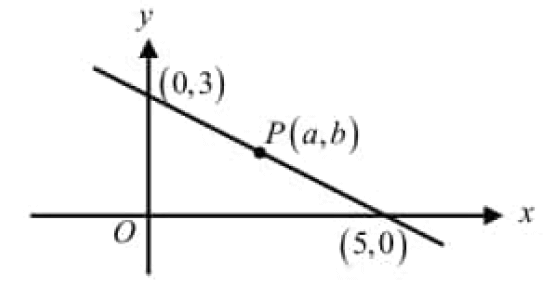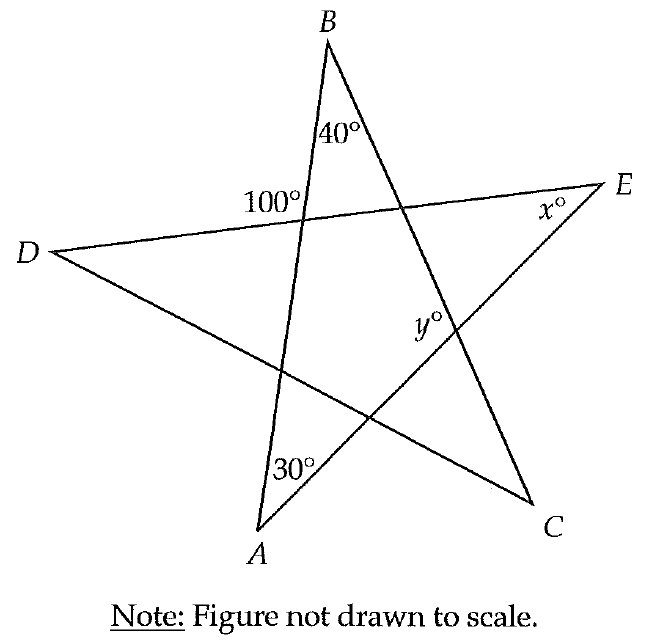FINDING AREA AND PERIMETER OF A PARALLELOGRAM
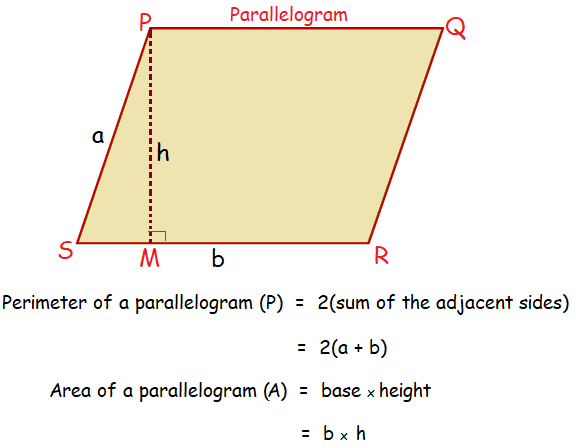
Find the area and perimeter of the following parallelograms :
Problem 1 :
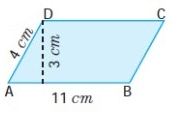
Solution :
From the figure,
Base of a parallelogram (b) = 11 cm
Height of a parallelogram (h) = 3 cm
Then,
Area of the parallelogram = b x h sq. units.
Area = 11 x 3
So, area of the parallelogram = 33 sq. cm.
Perimeter of the parallelogram = sum of the length of the four sides.
= 11 cm + 4 cm + 11 cm + 4 cm
So, perimeter of the parallelogram = 30 cm
Problem 2 :
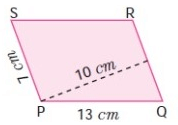
Solution :
From the figure,
Base of a parallelogram (b) = 7 cm
Height of a parallelogram (h) = 10 cm
Then,
Area of the parallelogram = b x h sq. units.
Area = 7 x 10
So, area of the parallelogram = 70 sq. cm.
Perimeter of the parallelogram = sum of the length of the four sides.
= 13 cm + 7 cm + 13 cm + 7 cm
= 40 cm
Problem 3 :
Find the missing values.

Solution :
(i)
Base of a parallelogram (b) = 18 cm
Height of a parallelogram (h) = 5 cm
Then,
Area of the parallelogram = b x h sq. units.
Area = 18 x 5
So, area of the parallelogram = 90 sq. cm.
(ii)
Base of a parallelogram (b) = 8 m
Area of the parallelogram = 56 sq. m
Then,
Area of the parallelogram = b x h sq. units.
56 = 8 x h
56/8 = h
7 m = h
So, height of a parallelogram (h) = 7 m
(iii)
Height of a parallelogram (h) = 17 mm
Area of the parallelogram = 221 sq. mm
Area of the parallelogram = b x h sq. units.
221 = b x 17
221/17 = b
13 mm = b
So, base of a parallelogram (b) = 13 mm.
Problem 4 :
Suresh won a parallelogram – shaped trophy in a state level chess tournament. He knows that the area of the trophy is 735 sq. cm and its base is 21 cm. what is the height of that trophy?
Solution :
Given,
Base of the trophy (b) = 21 cm
Area of the trophy = 735 sq.cm
Area of the parallelogram = b x h sq. units.
735 = 21 x h
735/21 = h
35 cm = h
So, height of trophy (h) = 35 cm
Problem 5 :
Janaki has a piece of fabric in the shape of a parallelogram. Its height is 12 m and its base is 18 m. She cuts the fabric into four equal parallelograms by cutting the parallel sides through its mid – points. Find the area of each new parallelogram.
Solution :
Given,
Base of a parallelogram (b) = 18 m
Height of a parallelogram (h) = 12 m
Area of the parallelogram = b x h sq. units.
= 18 m x 12 m
= 216 m2
Since she cuts the fabric into four equal parallelograms,
= 216/4
= 54 m2
So, the area of each new parallelogram = 54 m2.
Problem 6 :
A ground is in the shape of parallelogram. The height of the parallelogram is 14 meters and the corresponding base is 8 meters longer than its height. Find the cost of levelling the ground at the rate of $ 15 per sq. m.
Solution :
Given,
Base of a parallelogram (b) = 8 m
Since base is 8 meters longer than height,
Now, base = (14 + 8) = 22 m
Height of a parallelogram (h) = 14 m
Area of the parallelogram = b x h sq. units.
= 22 m x 14 m
= 308 m2
Cost of levelling 1 m2 = 15 per sq. m.
Cost of levelling 308 m2 = 308 x 15
= $ 4,620
So, the cost of levelling the ground = $ 4,620
Kindly mail your feedback to v4formath@gmail.com
We always appreciate your feedback.
©All rights reserved. onlinemath4all.com
Recent Articles
-
Digital SAT Math Problems and Solutions (Part - 134)
Apr 02, 25 12:40 AM
Digital SAT Math Problems and Solutions (Part - 134) -
SAT Math Resources (Videos, Concepts, Worksheets and More)
Apr 02, 25 12:35 AM
SAT Math Resources (Videos, Concepts, Worksheets and More) -
Digital SAT Math Problems and Solutions (Part 135)
Apr 02, 25 12:32 AM
Digital SAT Math Problems and Solutions (Part 135)
